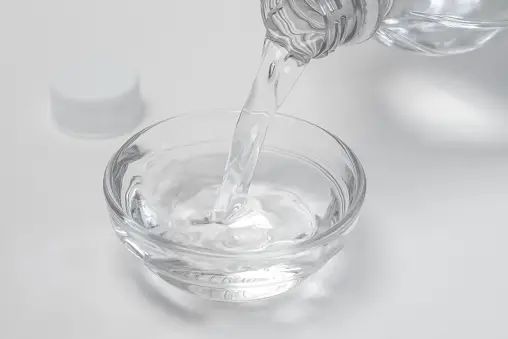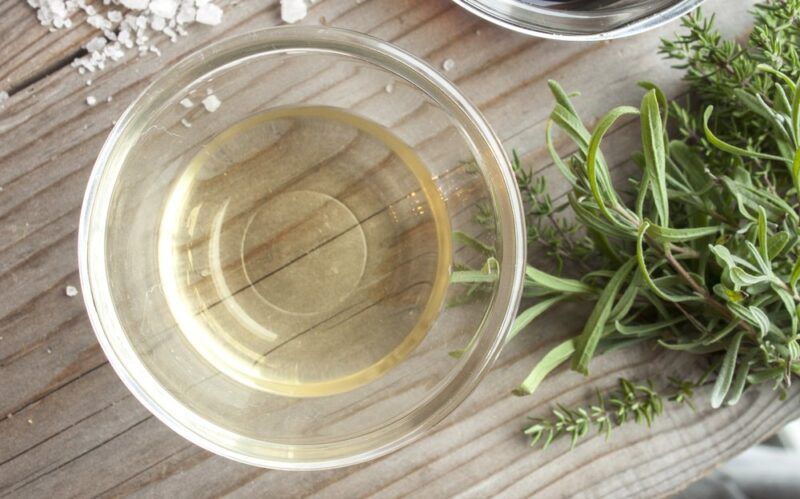White Wine Vinegar vs White Vinegar: What’s The Difference?
Vinegar is one of the most essential ingredients used across a multitude of cuisines worldwide. The tangy, acidic liquid brightens up dishes and provides the perfect balance of flavors. With an array of vinegar options available today, it is important to discern the differences between them to determine which suits your cooking needs best. Two commonly used types are white wine vinegar and distilled white vinegar. But what sets them apart?
An Overview of Vinegar

Before diving into the distinct qualities of white wine vinegar and distilled white vinegar, it is helpful to understand what vinegar is at its core. Vinegar consists primarily of acetic acid and water. It is produced through a double fermentation process.
First, sugars are converted to alcohol through yeast fermentation. Then acetic acid bacteria interact with the alcohol and oxygen to transform it into acetic acid, resulting in vinegar’s sour taste. The amount of acetic acid present determines the strength and intensity.
While vinegars have acetic acid in common, variables in the fermentation process impart subtle flavor differences to the end product. When choosing between white wine vinegar vs regular white vinegar, it is the production method that makes all the difference.
Comparing White Wine Vinegar and Distilled White Vinegar
White wine vinegar and distilled white vinegar (also known as spirit vinegar) have some overlapping characteristics. However, they vary significantly in terms of flavor, intensity, aroma, appearance, and ideal usage. Discerning the nuances is key to making the right vinegar choice for recipes.
A Closer Look at White Wine Vinegar
White wine vinegar is derived from fermenting white wine. The alcohol present in wine transforms into acetic acid when combined with bacterial cultures under carefully controlled conditions. Premium white wine vinegars are aged in wooden barrels for months or even years, resulting in a complex, nuanced flavor profile.
Given its wine origins, this vinegar variety has a pale golden hue and delivers a mild, tangy, fruity taste. It strikes the perfect balance between acidity and fruitiness. The fragrant aroma often carries apple, honey, or floral notes.
In cooking applications, white wine vinegar’s subtle, delicate properties shine in salad dressings, sauces, pickled vegetables, and marinades for chicken or fish. It provides a complexity that works well in Mediterranean and French cuisines.
The Qualities of Distilled White Vinegar
In contrast to white wine vinegar, distilled white vinegar is derived from diluted, distilled alcohol like corn or barley mash. Through fermentation with acetic acid bacteria, the alcohol transforms into a colorless liquid with potent acidic and sour flavors.
The production process removes any impurities or color, resulting in a crystal clear vinegar with an intensely pungent smell and biting taste. It lacks the subtle fruitiness and instead has a harsh sourness.
Due to its very strong acidity and astringency, distilled white vinegar is rarely used directly in cooking. It requires significant dilution with water. However, its powerful properties work well for household cleaning, weed control, and pickling. It can also safely sanitize surfaces.
What is The Difference between White Wine Vinegar and White Vinegar

While white wine vinegar and distilled white vinegar share the main component of acetic acid, they differ significantly in terms of:
Fermentation Process
White wine vinegar is made from the fermentation of white wine. The wine is allowed to turn sour by exposing it to oxygen which allows acetic acid bacteria to grow. The bacteria consume the alcohol in the wine and convert it into acetic acid, the main component of vinegar. This is an aerobic process that can take weeks or months depending on factors like temperature. The resulting vinegar has a subtle fruity flavor and aroma from the original white wine.
White vinegar, on the other hand, is made from the fermentation of distilled grain alcohol. The grain alcohol is diluted with water to around 5-8% alcohol and then inoculated with acetic acid bacteria. As the bacteria metabolize the alcohol, it gets converted to acetic acid. This usually occurs quickly over a matter of hours or days since the bacteria have direct access to the alcohol. The resulting vinegar does not have flavor carryover from a source material like wine.
Appearance
There are some clear differences in the appearance of white wine vinegar versus white vinegar. White wine vinegar tends to have a pale, golden color with a bit of a yellow or amber tint. It is often cloudy or hazy since there are subtle residues from the grape fermentation. The color can range from quite pale to more golden depending on the type of white wine used. Dry, light white wines produce lighter vinegars.
White vinegar derived from grain alcohol has a crystal clear appearance, like water. There are no residues or particles since it comes from the distilled alcohol. The vinegar will be completely transparent and colorless. While most white vinegar is clear, some variations are available that include apple cider vinegar or malt vinegar which can have a pale golden or brown hue.
Taste
The taste profile of these two types of vinegar differs considerably based on the source materials. White wine vinegar has a much more subtle and nuanced flavor. It is tangy but still retains some of the fruit notes and acidity from the white wine grapes used to produce it. The flavor is complex with a balance between tartness and sweetness. Higher quality wine vinegars will have a smooth mouthfeel.
White vinegar on the other hand has a very sharp, harsh taste. It is very high in acetic acid which comes through predominantly on the palate. The flavor can be overpowering and quite sour without any balance from residual sugars. There is no complexity of fruit flavors. The mouthfeel is also more acidic and can be unpleasant to some. White vinegar tastes quite strongly of vinegar alone.
Smell
There is a discernible difference in the aromas of these two vinegars. White wine vinegar has a milder, more subtle smell from the fruity wine character. There are delicate floral and fruit notes complementing the gentle vinegar aroma. It tends to have a rounded, mellow smell profile.
With white vinegar, the smell is dominated by intense vinegar notes. The acetic acid creates a very sour, pungent, and strong aroma. There are no additional layers of more pleasant fruity esters to balance out the harsh acidity. The smell can be quite offensive and overwhelming without any rounding.
Uses
White wine vinegar is more commonly used in culinary applications where flavor is important. It adds a delicate complexity to salad dressings, sauces, marinades, and other foods. The mild taste even allows it to be paired with fruits and sweets. White wine vinegar is especially popular in Mediterranean cuisine. It is too subtle to be used effectively as a household cleaner.
White vinegar has become a staple for cleaning and disinfecting purposes. It can be used to clean countertops, floors, windows, and other surfaces. The strong antibacterial properties also make white vinegar a powerful natural sanitizer. It can be used for washing produce and getting rid of food stains. The highly acidic profile suits household applications rather than cooking. The one exception is pickling where white vinegar is commonly used.
Substituting White Wine Vinegar and Distilled White Vinegar
Due to the stark differences in taste and intensity, white wine vinegar and distilled white vinegar are not typically interchangeable in recipes.
Substituting distilled white vinegar in place of white wine vinegar is not recommended, as it would lead to an unpleasantly strong, pungent flavor. The high acidity level could ruin delicate dishes.
Acceptable substitutes for white wine vinegar include:
- Champagne vinegar
- Sherry vinegar
- Rice vinegar
- Apple cider vinegar (in moderation)
- Lemon or lime juice
In a pinch, distilled white vinegar can be carefully diluted with water and added to salads with a light hand. Avoid using it for canning/pickling recipes calling for white wine vinegar, as improper acidity levels could lead to food spoilage and safety issues.
Health Benefits of White Wine Vinegar vs. Distilled White Vinegar
In addition to their culinary uses, both white wine vinegar and distilled white vinegar offer certain health benefits.
White wine vinegar provides:
- Antioxidants that improve heart health
- Aid for lowering bad cholesterol
- Promotion of healthy digestion
- Antibacterial properties
Meanwhile, distilled white vinegar assists with:
- Weight loss and appetite control
- Improved digestion
- Reduced water retention
- Antibacterial sanitizing ability
Both provide some benefits, but white wine vinegar’s flavor makes it better suited for direct consumption in foods and dressings.
Frequently Asked Questions
Is white wine vinegar similar to white vinegar?
While they share the main component of acetic acid, white wine vinegar and distilled white vinegar have stark differences in their flavor profiles, intensity, aroma, appearance, and ideal usage. White wine vinegar has a delicate fruity flavor while white vinegar is harsh and sour.
Is white vinegar or white wine vinegar better for baking?
White wine vinegar is ideal for baking lighter baked goods like cakes and biscuits, providing a nuanced tanginess. The more aggressive acidity of distilled white vinegar can react with baking soda, so it is not recommended in baking.
What vinegar is closest to white wine vinegar?
The best substitutes for white wine vinegar are champagne vinegar, sherry vinegar, and rice wine vinegar. All provide similar acidity and fruit-forward flavors. Avoid subbing in distilled white vinegar.
What is white wine vinegar also called?
White wine vinegar may also be referred to as vin Blanc or white vinegar. However, plain “white vinegar” typically refers specifically to distilled white vinegar, not white wine vinegar.
Conclusion
Vinegar comes in many forms, and it is important to discern between white wine vinegar vs white distilled vinegar. While both contain acetic acid, the production process and ingredients used set them far apart in terms of aroma, taste, appearance, and ideal usage.
White wine vinegar provides a delicate fruitiness that shines in cooking applications and dresses up salads beautifully. Meanwhile, highly acidic and pungent distilled white vinegar is better reserved for household cleaning and weed control rather than food preparation.
Making the right choice comes down to the needs of the recipe and your personal vinegar preferences. But understanding the distinct qualities of each vinegar empowers you to make that choice wisely. So don’t be afraid to think outside the (wine or distilled) box and get creative with how you incorporate these fundamental kitchen staples!






